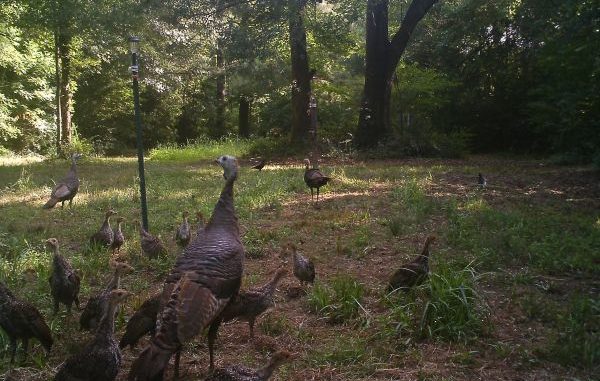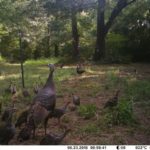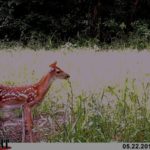
Remote cameras provide great insight about wildlife recruitment
Trail cameras are regularly used by hunters to monitor wildlife visits to feeders during the hunting season.
Checking cameras prior to hunting has pretty much replaced the art of finding sign — you know, looking for tracks, droppings, trails and the like. I guess it is just part of this world of high technology that we live in.
You can even set a camera up that is linked to your phone, allowing you to view animal visits from your desk.
The fact is that trail cameras can do much in providing valuable information regarding wildlife populations for which you are managing.
Knowing the population density of a wildlife species is a must for sound management. Just because a hen turkey lays a dozen eggs does not mean there will be a dozen new turkeys on the habitat. A woodduck hen might lay a dozen eggs in the box that you put up, but it does not mean there will be a dozen ducklings jumping out the hole.
The twin fawns a doe gave birth to might not escape the jaws of a coyote or the swinging blades of a tractor bush-hog.
Using the trail cameras to monitor these new born species of wildlife will give you data about actual survival and recruitment into the population.
Wild turkeys
Every summer, Jimmy Stafford, LDWF turkey biologist, sends out a letter to landowners asking for assistance in monitoring the turkey hatch and determining recruitment for the various regions of the state.
Landowners record turkey sightings July 1 through Aug. 31. From this data a Turkey Poult Production Index is developed based on these observations.
The northwest region of the state had the highest index last year, with 2.7 poults per hen. Three poults per hen is considered excellent production.
Last year in Southeast Louisiana, the turkey production was 1.1 poults per hen, which is low.
On our small property last summer, I observed only two poults with three hens (.6 poults per hen).
I set up my trail cameras at various locations to document turkey movement, and then use the photographs to supplement my sightings and determine the production that occurred on our tract.
I am generally baiting for hogs at this time, so turkeys often frequent this site.
Dusting sites also provide excellent opportunities to set up trail camera and photograph turkeys.
Keep in mind that poults are often secretive, so you might not capture all of them at one time.
I began getting pictures of young turkeys on May 5, and have been seeing them ever since. This year, to date, there were three hens with about 16 poults — an average of five poults per hen, which is great.
This is the best hatch of turkeys I have seen on this tract since we bought it in 2007. All of these poults can fly quite well, so their chance of surviving is good. Hopefully this record hatch will equate to more gobblers over the next few years.
If you want to participate with the turkey survey, contact Jimmy Stafford at LDWF and he can set you up with the survey forms.
White-tailed deer
Trail cameras also offer opportunities to document antler growth and development during the spring and summer months.
In Desoto Parish, I keep a couple of feeders going all the time and have set up mineral sites next to the feeders.
I captured one photograph of a buck on May 9, and it shows exceptional growth early in the growing season. Of course, in Area 2 the breeding occurs early, as does the antler drop, so bucks begin growing their new sets of antlers much sooner than in the late-breeding areas.
These photographs aid in determining whether or not the habitat is providing the nutrition needed for body growth and antler development.
Trail cameras also aid in determining the number of fawns being recruited into the population. On the Desoto tract, I have photographs of two does with single fawns and one doe with twins. This equates to 1.3 fawns per adult doe.
If I estimate that there are 30 adult does on this property, then the overall production will be 39 fawns.
With 39 new deer being recruited into the population, I could easily harvest 30 deer this fall and not create problems for the herd — if I was just shooting deer for the freezer.
Generally, fawn recruitment equals about a third of the herd, which is the reason most deer managers try to achieve a 30-percent harvest of the population.
A good way to supplement data obtained from cameras is to keep records of deer sightings during the early bow season.
Documenting sightings of fawns, does and bucks can also aid in determining fawn production. For example, if we observed 20 does and 30 fawns on the tract in Desoto, then the number of fawns per doe was 1.5, a little higher than what the camera survey found.
What is important is that the two surveys were very similar, so now we have a fair idea of what our productivity is, and perhaps that will help us determine what management work needs to be done to improve it.
Remember, on good habitat and with a balanced herd, adult does should be producing twins.
Woodducks
Everyone is familiar with the use of duck boxes to enhance woodduck productivity. Woodduck boxes provide additional nesting sites for these ducks and, once established, are used regularly by the birds.
Hooded mergansers and black-belly tree ducks will also use nest boxes.
Generally, the technique used to determine box usage and duck productivity is to check the boxes after the eggs have hatched and see how many actually hatched. A hen generally lays about 12 eggs, but all of them might not hatch.
While counting eggs gives some idea of nesting success, it does not necessarily mean all of the ducklings survived to become part of the population. This is where observation comes into play — going into the field in areas where hens might have broods and counting ducklings.
This can be somewhat time consuming, and can be a hit-or-miss venture.
I have put up duck boxes on several lakes and ponds on the Desoto tracts, and the woodducks use them each year. Last year, I set up a feeder on the big lake and left it out all year. The woodies, along with other duck species, used it regularly.
The feeder is situated between two woodduck boxes, and this spring the trail camera I had set up to record ducks at the feeders photographed three hens with their broods.
One hen hatched off real early and produced three ducks, another hen has 10 ducklings and another hen was photographed with three ducklings paddling along with her.
So our production was 18 ducklings produced by three hens, which equates to six ducklings per hen.
But it is still early in the life of these ducklings, and all of them might not survive to be added to the population of ducks; it does, however, give us proof that our woodduck program is working and producing ducks.
The fawning season is under way, so if you want to do some biology work and see what is going on with your deer herd, set trail cameras out on trails or in feeding patches and document you deer productivity. Mineral sites offer an excellent location to photograph does and fawns.




